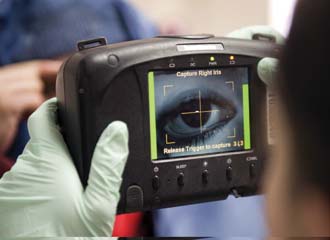Making Battlefield Intelligence "iPad Easy"
The U.S. Army is enhancing its premier intelligence distribution system in Afghanistan and around the world so that vast amounts of data are more accessible through cloud computing, laptops and handheld devices. It once took analysts days or weeks to sort through millions of files, but with the enhancements, they can do the same work in real time, which increases situational awareness and allows warfighters to make more informed decisions much faster.
 |
|
The Distributed Common Ground System (DCGS) contains a petabyte of data from space, aerial and terrestrial intelligence, surveillance and reconnaissance systems, including biometric information collected by soldiers on the ground. The intelligence data is becoming more readily accessible and faster and easier to use under enhancements being made by the project management office. |
U.S. Army officials are moving reams of intelligence data in Afghanistan to the cloud.
The U.S. Army is enhancing its premier intelligence distribution system in Afghanistan and around the world so that vast amounts of data are more accessible through cloud computing, laptops and handheld devices. It once took analysts days or weeks to sort through millions of files, but with the enhancements, they can do the same work in real time, which increases situational awareness and allows warfighters to make more informed decisions much faster.
Traditionally, Army officials say, analysts would rely on Boolean search to sort through massive amounts of data. Then they would print out an intelligence report, highlight important sections, create brackets on a board and make associations before finally putting together a graphic that shows the who, what, when and where on the battlefield.
“It was not that long ago that intelligence analysis was a very labor-intensive business,” explains Col. Charles Wells, USA, an intelligence officer currently serving as the Army project manager for the Distributed Common Ground System–Army (DCGS-A). “With the cloud and with lightweight applications that run analytics, we can now look through all that data—all 20 million records—and literally in a matter of seconds to minutes get a diagram that has been provided and start the analysis from there. We’re not having to filter the data. We’re not having to look at a subset of the data. We’re looking at every one of those records in real time, and getting an answer. A lot of the manual grunt work can now be done in a matter of minutes or seconds.”
The Army is achieving those warfighter benefits by upgrading the DCGS-A, which is the service’s primary system for posting, processing and disseminating intelligence, surveillance and reconnaissance information. The DCGS-A enables commanders to task battlespace sensors and receive intelligence information from multiple sources. It also facilitates battlespace visualization and situational awareness, maximizing combat effectiveness.
The DCGS-A contains data from 409 different sources, including space, airborne and terrestrial assets. It includes databases with detailed intelligence on the threat posed by improvised explosive devices, as well as biometrics data collected by individual soldiers. It essentially contains every intelligence report since 2003, a full petabyte of data.
The DCGS-A is a major acquisition program with numerous industry partners large and small. Contractors working on the program include Data Tactics, Northrop Grumman, General Dynamics and Lockheed Martin. Lockheed Martin is one of seven prime vendors competing for task orders under the Army’s DCGS-A indefinite-delivery, indefinite-quantity contract, and the company plays a major role in developing the DCGS-A Integrated Backbone. “The soldiers have limited time, a lot of data and a lot of responsibility, so we’re really focused on giving them the tools and the capabilities to allow them to do their jobs quicker, to allow them to improve the intelligence that they have and that they create so that they have better situational awareness,” says Jack Parran, the DCGS-A program manager for Lockheed Martin. “Col. Wells has focused on providing the analytical tools to allow soldiers to comb through the overwhelming amount of data and to find the needle in the haystack.”
Parran adds that Army analysts typically are “young guys who have not been around for decades, so they need something they’re used to.” That is why the Army is focused on making the DCGS-A “iPad easy,” so that using it is as intuitive for today’s soldiers as the devices they commonly use in their private lives.
Every service uses a version of the DCGS, which replaces a variety of older, stovepiped intelligence ground stations. Because each service operates differently, each has its own version, but the different versions are built on a common architecture for greater information sharing among the services.
The Army’s move to the cloud environment and other enhancements are being instituted in response to a 2010 Joint Urgent Operational Need statement generated by then-Maj. Gen. Michael Flynn, USA, who at the time was one of the top-ranking intelligence officials in Afghanistan. Gen. Flynn has since received his third star and is now serving as an assistant director of national intelligence.
 |
|
The DCGS-A contains 20 million files—every intelligence report since 2003. Later this year, enhancements to the system potentially could enter full deployment, making data more quickly available to warfighters in Afghanistan and around the world. |
“The bottom line, Gen. Flynn told us, is that traditional analytical tools were not up to the task in Afghanistan,” Col. Wells recalls. “It is a very complex environment where you’ve got a requirement to have these diagrams of who is doing what, when and where, and you want those very quickly and with the absolute latest data. He felt the traditional tools the intelligence community had fielded were not sufficient for the task.”
Fortunately, Wells and his team already had some enhancements in the works that would meet the warfighters’ urgent operational needs. Those enhancements included laptops with the DCGS-A software to be used from more remote locations, such as forward operating bases, as well as moving the DCGS-A data to a cloud computing environment Col. Wells and his team worked with warfighters and with the requirements officials at the service’s Training and Doctrine Command, Fort Eustis, Virginia, to accelerate the schedule for the enhancements.
“The game-changer of cloud technology is that we don’t have to bracket the data any more. We have enough computing storage and horsepower that we can load all of the intelligence products into a cloud node and conduct real-time analysis of all that data,” Col. Wells says.
About a year ago, the Army delivered the first cloud node to Bagram, Afghanistan, the headquarters location for Regional Command–East, and achieved initial operating capability. The DCGS-A cloud node is available to any U.S. or coalition warfighter with a Web browser and with access to either the secret Internet protocol router network or the coalition network. Because it can be accessed easily with any Web browser, the data also is becoming available via handheld devices, such as smartphones and tablets, which the Army is working to field.
To build in redundancy and improve connectivity, the project manager’s office is placing a second cloud node at Kandahar in Regional Command–South. That node was scheduled to meet initial configuration and operational capability last month. “Heaven forbid a mortar round were to come in onto the cloud node at Bagram. You don’t want a single point of failure for the entire theater,” Col. Wells observes. Additionally, warfighters in Kandahar rely on a datalink to connect to the cloud node in Bagram, but it is possible that the datalink at some point could be interrupted, degraded or completely lost. Installing the second node eliminates that risk.
Cloud nodes also are being added in Wiesbaden, Germany, to support the U.S. European Command, and in Hawaii for the U.S. Pacific Command.
Furthermore, the project office also is deploying prototype edge nodes, Col. Wells reports. “In the next several months, we’re going to be deploying these cloud-edge nodes to demonstrate that we can put the same capability in a smaller form factor to go out to these remote forward bases,” Col. Wells reveals. The edge nodes save size, weight and power, which are critical considerations in deploying information technologies on the battlefield. “That’s why we’re looking at solid-state capabilities instead of the traditional spinning hard drive—because you get more power for less weight, and it’s a lot easier to get something like that downrange,” Col. Wells observes.
The project management office also is fielding laptops known as the Multi-Function Work Station (MFWS), which is loaded with version three DCGS-A software known as Griffin. On February 29, the Defense Department gave approval for the Griffin software to move into the production phase, positioning the system for operational testing at Fort Stewart, Georgia, in May and June. Based on the results of those tests, the system could be approved for full deployment in the fall, which would allow the software to be fielded across the entire Army. The Army intends to update the DCGS-A software approximately every 12 months.
In addition, the team is deploying Coral Reef software, which allows analysts using DCGS-A intelligence to more easily see and understand relationships between persons of interest. That data also will be available on handheld devices and available to soldiers on the ground. “Coral Reef is a way to analyze a major data source to provide the analyst the ability to mine significant amounts of data and provide suggestive associations between individuals to build out that social network. “Previously, we would mine through those intelligence reports or whatever data would be available, and that would be very manual-intensive,” says Mark Kitz, DCGS-A technical director for the Army.
Coral Reef and the DCGS-A cloud environment are both developed by the National Security Agency, which means the Army is using the “gold standard” in secure technology, Col. Wells points out.
“All this means having a better understanding of the situation. It gives warfighters a critical understanding of their situation in whatever scenario they’re fighting in,” Col. Wells says, summing up the benefits of DCGS-A enhancements. “When you can get something like that downrange to support the warfighter, that’s what being a project manager is all about.”
WEB RESOURCES
DCGS-A project manager: http://dcgsa.apg.army.mil/docs/ProjectManagersView.pdf
DCGS-A program: http://dcgsa.apg.army.mil/index.html




Comments